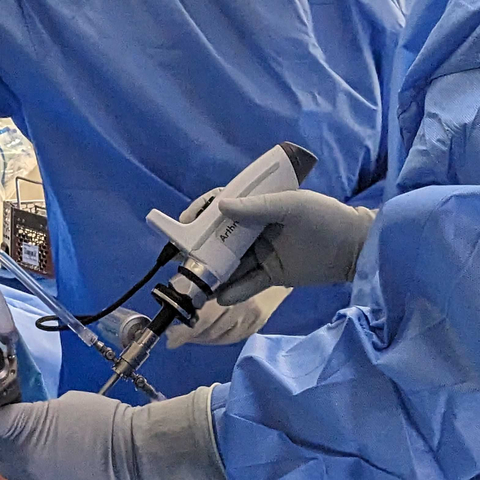CLEVELAND– Medical device and technology company Lazurite® announced that a new article just published in the Journal of Orthopaedic Experience & Innovation provides key support for the usability of the company’s ArthroFree® wireless surgical camera.
In a human factors usability analysis of the camera system involving 88 participants, 94.32% of respondents gave a “good” or “excellent” response to the statement, “The absence of cables will have a positive impact on efficiency,” and 90.91% gave a “good” or “excellent” response to the statement, “The absence of cables will have a positive impact on patient safety.” More than 88% (88.10%) agreed with the statement, “I could perform surgery with the same degree of confidence [as my current device].”
Separate one-on-one interviews with surgeons on their independent experience with ArthroFree pointed to “untethered movement” as the most important benefit of using the device.
ArthroFree is the first FDA-cleared wireless camera for arthroscopy and general endoscopy, both areas of minimally invasive surgery. The device is an alternative to the conventional camera used in minimally invasive surgery, which has two cables, one for power and one for fiber-optic light, tethering it to instrumentation boxes on a surgical tower. The cables can be cumbersome, routed around or across the patient, and risk bridging the sterile and nonsterile fields.
Feedback on the ArthroFree camera system’s usability was received from 82 surgeons and six other medical professionals. Topics surveyed included ergonomics, ease of use, image quality, and patient experience. Surveys were collected following design validation testing (pre-FDA clearance; 76 participants) or clinical evaluation (post-FDA clearance; 12 participants).
Participants with wide-ranging levels of experience in minimally invasive surgery were recruited from 10 medical facilities. They were trained on the use of ArthroFree and then used the device in a surgical procedure performed on a patient or model. Their experience was evaluated in a 13-statement human factors survey scored using a 5-point Likert scale. Participants scored the device’s usability “good” or “excellent” in all survey statements, suggesting users’ needs were satisfied in 91.30% of participants.
To complement the usability analysis, one-on-one interviews were conducted with 15 surgeons from nine medical facilities gathering qualitative feedback on their independent experience with the ArthroFree device. Each surgeon was asked to comment on the potential benefits of using the device. All 15 volunteered “untethered movement” as an expected benefit. Other benefits cited by more than half of those interviewed include decreased setup and teardown time (11/15), and increased efficiency in the OR (8/15).
“The ArthroFree Wireless Camera System is designed to free the surgeon from the tethers of video power and fiber-optic light cables in order to allow more ergonomic and efficient surgical movements and enhance the safety of the OR,” said Dr. Jeff Ustin, a critical care surgery specialist at University Hospitals and Akron General Medical Center. “The favorable survey scores and benefits expressed by surgeons in this analysis support the usability of the first wireless surgical camera and a high likelihood of user adoption.”
“The publication of the usability analysis is the culmination of the initial phase of our collaboration with Lazurite in support of its ArthroFree wireless camera system,” said Kipum Lee, vice president of innovation & product strategy at UH Ventures, the innovation and commercialization arm of University Hospitals. “The usability analysis represented a great opportunity for our surgeons and surgical teams to use the device. This type of immersive observation and data gathering is one of the key engagement services we provide through our UH Ventures platform.”


